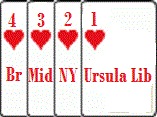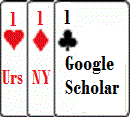We have created an educational activity based on the game 51, a rummy card game in which the players match categories or create straights (4 numbers in succession of the same suit); the player which reaches 51 (or is the closest to 51) wins the hand (“The Game of Kalooki 51”). We decided to switch the game up by implanting common research tools in lieu of the traditional card symbols. There will be 25 cards in the deck that can be
matched by straight:  (“The Game of Kalooki 51” edited by Alae Mito)
(“The Game of Kalooki 51” edited by Alae Mito)
or matching numbers  (“The Game of Kalooki 51” edited by Alae Mito).
(“The Game of Kalooki 51” edited by Alae Mito).
At the end of three games the students will be introduced to a variety of search tools including libraries, newspapers, scholarly sites, and databases. The idea outcome is for students to use the search modalities which they were exposed to during the game. As a group we had a general idea of how to play the game, we decided to Google an official game website which included the rules, images, and other general information that helped us to create our own version of the game. After getting the basics of our game down we decided to look further into what makes an educational program effective. The article “Moving Learning Games Forward” gave us an educational insight into how our own prototype should be designed and what our parameters should be in regards to learning objectives. As per the authors educational games should engage the following:
“1. game can engage players in learning that is specifically applicable to “schooling;”
2. there are means by which teachers can leverage the learning in such games without disrupting the worlds of either play or school.” (Klopfer, Osterweil, and Salen).
Our game fulfills both of these requirements; the images on the cards are in direct correlation with search options that they can use for both academic and societal research. Teaching professionals are also able to gauge the learning outcomes of this activity by controlling which resources are provided on each card and evaluating which resource the students are actually utilizing after the game has been completed. They are also able to make a distinction between actual card games and the educational benefits that are received through this game by gauging the quality of their students work. Lastly, we needed to generate images in order to visually express what we expected our game to look like. After finding a website which showed the various winning hands in 51 we borrowed those images and modified them in order to express how our own version would be represented. Using the paint application (found on most desktops) we were able to create a representation of our idea.
The research we initiated was essential to our overall outcome of the project. First and foremost we needed to obtain and agree upon a standardized set of rules and procedures from the original game that could be adapted to our educational version. This was accomplished by utilizing “Royal Rummy” which gave step by step instructions, pictures, and outcomes of the game. Once the preliminaries were in place it was important to research what makes a well rounded, effective educational game. This is where a review of “Moving Learning Games Forward” was helpful. There were tips and conclusions which researchers had previously drawn about what makes an effective educational game that we were able to use for our own game development. It would be easy to create a game but ensuring its effectiveness to actually be of value to students is essential. Through this article we were able to see what works for these types of activities and what must be included in order to enhance learning for the student and control variables for the teacher. Lastly we had to create the images in order to properly dictate our vision. These images were clearly shown and displayed on one of our resources. We were quickly able to adapt our own version of play to the pre made images as a way to enhance our presentation. Without the research tactics we used this project would have been difficult to complete. We needed to put in the work in order to not only ensure we had a properly functioning game but to also ensure that the activity included educational techniques that would be beneficial to both the instructors and the students.



